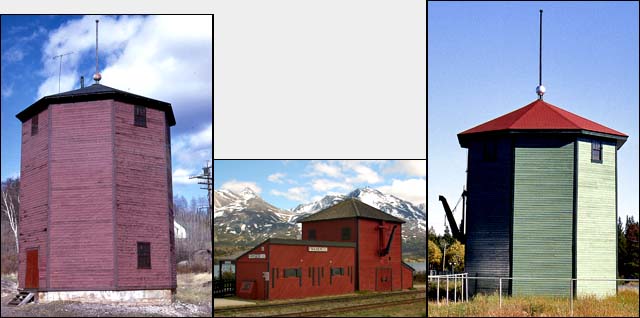
2012
|


Typical enclosed Canadian water tanks. (left to right) Canadian Pacific at Franz Ontario - Date/Photographer unknown,
White Pass & Yukon Route at Fraser British Columbia - Date/Photographer unknown, Pacific Great Eastern at Lone Butte, British Columbia - 18 Dec 1991 Bill
Hooper.
10 February 2012
The Cold Facts on Water for Locomotives
Canada - This week, Collected Wisdom has a marked transportation theme as we answer queries about trains and boats and planes. Well,
okay, we lied about the boats.
THE QUESTION
Robert G. Wuetherick of Edmonton wonders how, in the past, water stored in towers for steam locomotives was kept from freezing in winter.
THE ANSWER
"In locations where water towers were prone to freezing, Canadian railways enclosed the water towers inside wood-framed octagonal structures," writes
Gordon D. Jomini of Fredericton. The structures were not insulated and heating was provided by "a large coal-burning stove inside, under the water tank.
To extract the last bit of heat from the coal fire, the flue (chimney) for the coal stove was run through the water tank."
He says the octagonal enclosure and the water tank inside were entirely separate structures. "The bigger railways, Algoma Central, Canadian National,
Canadian Pacific, Northern Alberta, Ontario Northland, and Pacific Great Eastern, each had their own standard designs."
He points out that these structures were called octagonal water towers even though the actual water tank inside was cylindrical. He also says he has never seen
a picture of one of these octagonal towers in the United States, "so the structures might have been unique to Canadian railroading. Certainly, the
enclosures were very, very large structures."
David Page of Kingston adds that for water tanks with no coal-fired heating, other means of preventing freezing would have been available, depending on
location and water supply. "These could have included steam from the workshop or station heating plant, water flow if the tower was in big demand, and
possibly draining the tower in winter if not essential to railway operations."
Philip Jackman.

|
